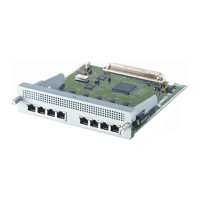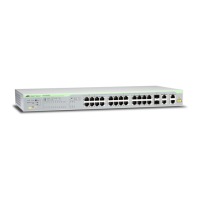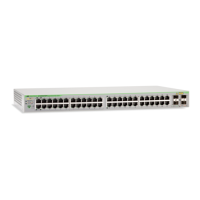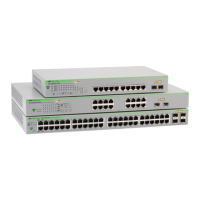EPSR and (R)STP Interaction Introduction
4-147
Software Reference for SwitchBlade x3100 Series Switches (Layer Two Switching)
4.6.14.2 Configuration Overview - EPSR and (R)STP
The communication of STP/RSTP information to other bridges via the exchange of messages known as Configu-
ration Bridge Protocol Data Units (BPDUs), Topology Change Notification (TCN) BPDUs, and RST BPDUs.
For the feature interaction, these take place as part of the STP/RSTP processing on the NSP product nodes which
are configured to run EPSR and STP/RSTP together, as well as the nodes which are only running STP/RSTP.
4.6.14.3 Configuration Requirements - EPSR and (R)STP
Following are the key concepts/parameters that must be understood for the feature interaction to function cor-
rectly:
• Protocol Communication (BPDUs)
For ports that are participating in both EPSR & STP/RSTP, when the STP/RSTP processing that is “attempt-
ing” to control the spanning tree states of alternate or backup ports indicates that those ports are in a
“blocked” or “discarding” state, BPDUs will not be transmitted on those ports, even though in fact they are
actually “forwarding” due to EPSR control.
There is also communication added between the EPSR protocol and STP/RSTP within the NSP product node
to signal when a port has been unblocked as a result of the EPSR ring being restored to full service following
recovery of a failed link. This event will be processed rather than port enable event by the STP/RSTP feature.
• Convergence (selection of root bridge)
The root bridge for the overall Spanning Tree for the network in this type of configuration must either be one
of the EPSR ring nodes, or a bridge which is at a “higher level” in the network and connects directly via one
of the nodes on the EPSR ring. In other words the root bridge can NOT be a node from one of the STP/RSTP
sub-networks, nor can it be a “higher level” network node that only connects via a link to one of the STP/
RSTP sub-networks.
4.6.14.4 Port Costs
When a network is being setup to utilize an EPSR ring in conjunction with STP or RSTP sub-networks, the port
paths costs of all the links involved will need to be reviewed and potentially modified by the user. At a minimum,
the port path costs for all the “shared” links from the EPSR ring will need to be set artificially low (e.g., to a value
of 1,2, or 3) to keep the STP/RSTP algorithm processing from attempting to block those links.
In addition, whenever STP sub-networks are in use, it may be necessary to raise the path costs of the links in each
STP sub-network such that the combined cost for a traffic path through any one of those sub-networks can not be
lower than the cost to traverse the EPSR ring.
Note: This will only be an issue in a scenario where a link (or bridge) on the EPSR ring has failed.
This restriction is a side effect of the low magnitude and limited range of path cost values used for STP. When
RSTP is in use, the same general principal applies (i.e., RSTP sub-network path costs must be greater than path
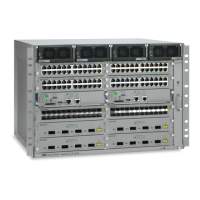
